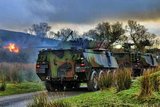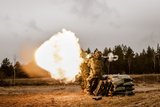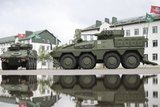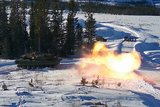Ukraine tests anti-tank missiles bought from US
Ukraine on 22 May carried out tests of the top of the range Javelin anti-tank missile it recently bought from the US to boost its arsenal against Russian-backed rebels.
Ukrainian President Petro Poroshenko posted video on Twitter showing a missile being fired and blowing up a target at a military testing ground.
Poroshenko said after the test, which he claimed boosted Ukraine's military capabilities as it fights a long-running conflict with Russian-backed separatists in its east: ‘Finally the day has come. I'm sure that as of today the military capabilities of the Ukrainian armed forces... grew significantly.’
The Javelin missiles will only be used in defence when Ukrainian positions are attacked, he said.
The US in March 2018 formally approved the sale of 210 missiles and 37 launchers by contractors Raytheon and Lockheed Martin to Ukraine at a price of around $47 million.
Poroshenko on 22 May thanked US President Donald Trump, hailing the missile deal as a ‘symbol of cooperation with our American partners.’
The US and its Western allies back Ukraine in its struggle to reunite its country since 2014 when Russia annexed the Crimea peninsula and Russia-backed rebels seized two eastern industrial regions.
Washington had been cautious in the past about escalating the conflict by providing advanced ‘lethal’ weaponry to Kiev due to the risk of heightening tensions with Moscow.
But in December 2017 the US announced it would provide Ukraine with ‘enhanced defensive capabilities’ as the war in the east drags on, having claimed more than 10,000 lives since 2014.
In recent days, there has been increased fighting in eastern Ukraine, with at least four people killed on both sides and nine wounded on 21 May.
On 22 May, rebel authorities in the Donetsk region said that an explosive device went off in a passenger bus, killing one and wounding two.
More from Land Warfare
-
Germany signs multi-billion-dollar deals for 6x6 CAVS and GDELS Eagle vehicles
The order is a further boost for the Common Armoured Vehicles System programme which has notched notable successes in the past 12 months. The first vehicle, made in Finland, will be delivered next year with local production expected to ramp up in 2027.
-
![Rheinmetall and KNDS tank tie-up narrows trans-European options]()
Rheinmetall and KNDS tank tie-up narrows trans-European options
The French and German governments signed an agreement in June 2018 to cooperate on the development of a new main battle tank under the Main Ground Combat System programme but the effort has struggled. This new agreement may damage it further.
-
![2025 land market review: British Army woes, European heavy armour and US MBT progress]()
2025 land market review: British Army woes, European heavy armour and US MBT progress
The last year has seen several major procurements in the land market. Shephard’s Dr Peter Magill reviews the main trends and themes in land procurement of 2025.
-
![Hungary set to begin using Hero 400 loitering munitions]()
Hungary set to begin using Hero 400 loitering munitions
Developed by Israel's Uvision and with systems being sold in the thousands to multiple European NATO countries and the US, the Hero family of loitering systems is also in production in the US and Italy, the latter through Rheinmetall.
-
![Croatia orders Leopards and CAESAR howitzers as Lithuania orders more CAESARs]()
Croatia orders Leopards and CAESAR howitzers as Lithuania orders more CAESARs
The Leopard is becoming the tank of choice in central and eastern Europe as Croatia joins Lithuania, the Czech Republic and Hungary in ordering the platform. Lithuania and Croatia have also signed for CAESAR howitzers.
-
![Light Reconnaissance Strike – enabling a vital mission set (Studio)]()
Light Reconnaissance Strike – enabling a vital mission set (Studio)
A new system-of-systems concept will unlock digital integration of sensors and weapons for Light Forces, allowing them to shape the battlefield environment on their own terms and upgrade legacy platforms.

























